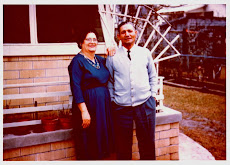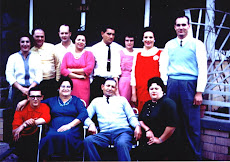
The pecan* tree in my side yard -- after several barren years -- is now loaded with appears to be a bumper crop. The race is on to see who gets them first -- me or the squirrels.
Pecan trees are common in Southern yards -- and recipes. The tree in my grandparents' back yard provided for the pies we ate at Thanksgiving and the pig tails we consumed at Christmas with enough left over to augment the odd batch or two of brownies or pralines.
In summer, we'd squint up into the branches, assessing the expected harvest. A rainy summer meant the nuts would be full with sweet, tasty meat. A dry summer foretold of shriveled nuts that wouldn't even tempt the hungriest squirrel.
The kids were the designated pickers; our young eyes and knees were better suited to the task. We shuffled around in the dried leaves, locating pecans with our feet before dropping to our knees and scooping them into brown paper grocery sacks (crawling around was quicker, but more painful). There was always a contest to see who could pick up the most.
After supper, everyone gathered to shell the nuts. The kitchen table was covered with newspaper. All the shellers were assigned a sack of pecans, a bowl and cracking and picking instruments.
Unlike today's paper-shells, these pecans were hard to crack as hickory nuts. The going was long and tedious with lots of breaks to flex cramped fingers.
The grown ups would start telling stories. Stories about the old hermit that lived on Deer Island ... the unfortunate boy whose head got squished like a watermelon between a piling and a passing boat ... the girl who wouldn't let the doctor remove the strawberry birthmark from her forehead and then bled to death when the blood vessels got caught in the teeth of her comb ... the champion swimmers that swam marathons out to the long-gone Isle of Caprice.
Those colorful, sometime even lurid, possibly totally fabricated stories kept us going through the tedium , sore wrists and fingertips and that irritating pecan dust that settled into cuts and scrapes. Eventually, the last pecan was cracked, the precious nuts divvied up into little plastic bags, the errant shells swept up off the floor and thrown away.
For days our fingertips would be tender and we'd see bags and bags full of pecans every time we closed our eyes.
But it was the stories that always stayed with me the longest.
* On Point Cadet (well in Mississippi in general) and in Louisiana, it is pronounced "puh-cahn" with the accent on the last syllable. Residents of Georgia and Tennessee adamantly insist the nut is a "pee-kan" -- accent on the "pee." I dunno -- sounds kind of unappetizing to me.
However, you pronounce it, one of my favorite uses of pecans is in the use of that famously Southern candy, pralines. Again, how you pronounce the name is a matter of geography. Here they are "prah-leens" not "pray-leens." My favorites are rich and creamy, not overly sweet or gritty. This recipe is easy in that you can make it in the microwave. Like meringues and humidity, pralines are best made on a day with low humidity. Good luck with that.
Microwave Pralines
Pecan trees are common in Southern yards -- and recipes. The tree in my grandparents' back yard provided for the pies we ate at Thanksgiving and the pig tails we consumed at Christmas with enough left over to augment the odd batch or two of brownies or pralines.
In summer, we'd squint up into the branches, assessing the expected harvest. A rainy summer meant the nuts would be full with sweet, tasty meat. A dry summer foretold of shriveled nuts that wouldn't even tempt the hungriest squirrel.
The kids were the designated pickers; our young eyes and knees were better suited to the task. We shuffled around in the dried leaves, locating pecans with our feet before dropping to our knees and scooping them into brown paper grocery sacks (crawling around was quicker, but more painful). There was always a contest to see who could pick up the most.
After supper, everyone gathered to shell the nuts. The kitchen table was covered with newspaper. All the shellers were assigned a sack of pecans, a bowl and cracking and picking instruments.
Unlike today's paper-shells, these pecans were hard to crack as hickory nuts. The going was long and tedious with lots of breaks to flex cramped fingers.
The grown ups would start telling stories. Stories about the old hermit that lived on Deer Island ... the unfortunate boy whose head got squished like a watermelon between a piling and a passing boat ... the girl who wouldn't let the doctor remove the strawberry birthmark from her forehead and then bled to death when the blood vessels got caught in the teeth of her comb ... the champion swimmers that swam marathons out to the long-gone Isle of Caprice.
Those colorful, sometime even lurid, possibly totally fabricated stories kept us going through the tedium , sore wrists and fingertips and that irritating pecan dust that settled into cuts and scrapes. Eventually, the last pecan was cracked, the precious nuts divvied up into little plastic bags, the errant shells swept up off the floor and thrown away.
For days our fingertips would be tender and we'd see bags and bags full of pecans every time we closed our eyes.
But it was the stories that always stayed with me the longest.
* On Point Cadet (well in Mississippi in general) and in Louisiana, it is pronounced "puh-cahn" with the accent on the last syllable. Residents of Georgia and Tennessee adamantly insist the nut is a "pee-kan" -- accent on the "pee." I dunno -- sounds kind of unappetizing to me.
However, you pronounce it, one of my favorite uses of pecans is in the use of that famously Southern candy, pralines. Again, how you pronounce the name is a matter of geography. Here they are "prah-leens" not "pray-leens." My favorites are rich and creamy, not overly sweet or gritty. This recipe is easy in that you can make it in the microwave. Like meringues and humidity, pralines are best made on a day with low humidity. Good luck with that.
Microwave Pralines
1 lb light brown sugar
2 T light corn syrup
1 cup whipping cream
2 T pure vanilla extra
2 T butter
2 cups whole pecans, toasted
Combine brown sugar, corn syrup and whipping cream in an 8-cup microwave safe bowl. Microwave on high 13 minutes, stirring every 2 minutes. Add butter and stir until well-blended and creamy. Stir in toasted nuts and drop by tablespoonfuls onto waxed paper. After pralines have cooled and hardened, carefully remove them from the waxed paper and store between waxed paper in an airtight container.



